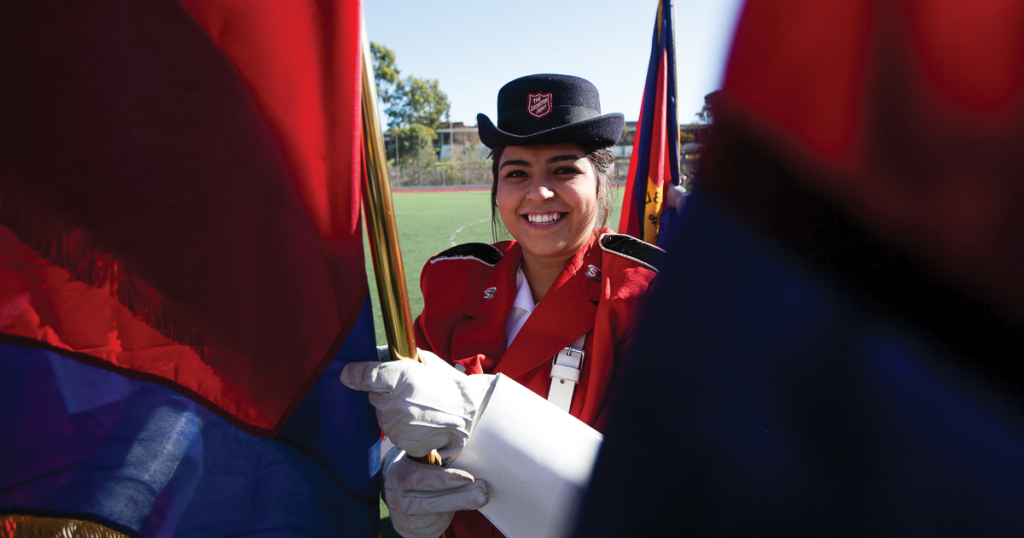The Salvation Army: A Glossary
An Overview of Salvation Army Organization, Function and Doctrine
Specialized Services Centers
Adult Rehabilitation Center (ARC) Ministry: The original concept of the Adult Rehabilitation Center comes from William Booth’s compassionate response to poverty and human suffering outlined in his seminal work, In Darkest England and the Way Out.
As the ministry now exists, although primarily aimed toward men, in certain centers accommodations exist for women as well. The program consists of a work treatment model for those suffering from alcohol and substance abuse addictions. An integral part of the treatment program is a strong Christian message underscoring the saving power of Christ in all situations, including addictions.
The ARC program is funded primarily through the sale of goods in its family thrift stores. The Salvation Army truck, a familiar sight across North America, is an important means of gathering needed donated goods.
KROC Corps Community Centers: Named for Ray and Joan Kroc who were the benefactors, a Kroc Corps Community Center is a specialized ministry that involves specific outreach via recreational and other programs with a corps that operates as an integral part of its ministry. There are 26 such centers operating exclusively in the USA.† †
Emergency Disaster Services: The Salvation Army’s response to disasters began in 1866 when the East London Christian Mission joined in efforts to bring relief during a cholera epidemic. Since the devastating tidal wave that claimed thousands of lives in Galveston, Texas in 1900, response to people affected by natural forces of floods, hurricanes, and tornadoes, as well as fires, has become a significant part of the ministry of The Salvation Army in the United States of America. Where local resources prove inadequate to cope or where there is no local presence of The Salvation Army in a particular place of a territory or country, Emergency Disaster Services teams are deployed across national borders to assist victims of disaster, war, and mass migration.
In the USA, response includes the mobile feeding units (canteens) that deliver meals, drinks and other emergency needs at the site of disasters. Long term aid continues as required to help communities recover. Officers, soldiers, employees and volunteers give unselfishly of their time and energy to provide immediate relief to those who have been victimized by disaster, whether natural or manmade.† †
Harbor Light Center: A rehabilitation center, usually located in inner city areas.†
Homeless Services: Shelters for men, women, and often families; also presenting hot meals in areas where homeless individuals and families congregate.
Emergency Financial Assistance: Multipronged efforts to alleviate burdens on people in crisis through programs ranging from heating fuel assistance to clothing and shelter. On a need basis.
Prison Ministry: Regular or periodic ministry such as visitation, Bible studies.
Social Services/Holistic Approach: Assistance with the additional aim to correct or improve behavior, thus hopefully eliminating future need for help. Programs such as the Pathway of Hope intervene to break cycles of poverty and build self esteem and self-sufficiency for those reached.†
Christmas: Red Kettle Drive; Angel Tree program; Toy Store and/or Distribution Center; Christmas feeding of homeless and indigent.
Doctrine
Soldier’s Covenant: The statement of beliefs and promises which every intending soldier is required to sign before enrollment. Previously called “Articles of War.” †
Holiness Doctrine: Based on Wesleyan beliefs regarding sanctification (“the second blessing”).
Commission: A document presented publicly, authorizing an officer, or local officer to fulfill a specified ministry.†
Governance
International Headquarters: The offices in which the business connected with the command of the worldwide Army is transacted.†
Zonal Departments: The main administrative link with territories and commands. The international secretaries give oversight to and coordinate the Army’s work in their respective geographical areas.†
Territory: A country, part of a country or several countries combined, in which Salvation Army work is organized under a territorial commander.†
Command: A type of small territory.†
Division: A number of corps grouped together under the direction of a divisional commander (may also include social service centers and programs), operating within a territory or command.†
Corps: A Salvation Army unit established for the preaching of the gospel, worship, teaching and fellowship and to provide Christian-motivated service in the community.†
Outpost: A locality in which Army work is carried out and where it is hoped a corps will develop.†
High Council: The constitutional body of The Salvation Army that elects the General.†
Advisory Board: A group of influential citizens who, believing in the Army’s program of spiritual, moral and physical rehabilitation and amelioration, assist in promoting and supporting Army projects.†
Pastoral Care Council: Established in each corps for the care of soldiers, etc, and maintenance of the membership rolls.†
Internal Organizations
Community Care Ministries/League of Mercy: Salvationists who engage in a caring ministry by responding to the spiritual and practical needs of the community.†
Corps Cadet: A young Salvationist who undertakes a course of study and practical training in a corps, with a view to becoming effective in Salvation Army service.†
Corps Council: A select group of local officers, soldiers, adherents and friends who meet to advise the corps officer on matters relating to the local expression of The Salvation Army’s mission in the local setting.†
Home League/Women’s Ministry: The Army’s international women’s organization.†
Medical Fellowship: An international fellowship of dedicated medical personnel.†
Men’s Fellowship Club: The Salvation Army’s international men’s organization.
Bands/Banding: Salvation Army bands have been a regular part of its musical forces since the first one was formed in 1878 in Salisbury, England. Almost always composed solely of brass instruments, bands are used to accompany singing in meetings, on the march as a means of witness and to perform in concerts. There are approximately 24,000 bandsmen and bandswomen worldwide.† †
Songster Leader: A member of the census board as the senior local officer responsible to the corps officer for the direction of the songster brigade. He or she may be assisted by a deputy, sergeant, secretary and color sergeant.† †
Sunday School: In the USA, the primary means of Bible study with classes geared for various age levels. The classes are normally held on Sunday morning before the weekly worship service.† †
Scouting – Boys: In the USA, scouting for boys has taken various forms, including troops affiliated with the Boy Scouts of America. The main program is an internal Salvation Army scouting program known as Adventure Corps. More recently, a group called Moonbeams has been organized for younger boys as well.† †
Scouting – Girls: The Salvation Army’s own internal scouting program for girls is comprised of two divisions: the Girl Guards for those 12 and older, and the Sunbeams, for girls 6-11 years old. Its basic purpose is “To Save and to Serve.”† †
Timbrels: In 1881 the War Cry carried a picture of “Miriam, a Forerunner of the Prophetess of The Salvation Army” with timbrel in hand. Charles Rothwell stationed at Mansfield, Nottingham, England, bought a tambourine in a pawnbrokers shop which Mrs. Rothwell played in the processions which the newspapers reported filled the “devil with disgust,” the barracks with people and helped sinners into the fountain. The use of the timbrel spread quickly. In 1882, George Scott-Railton noted that 1,600 had been sold in six weeks. Today the majority of Army corps feature a Timbrel Brigade in their music sections.
Membership
Envoy: A Salvationist who visits corps, societies and outposts, for the purpose of conducting meetings. An Envoy may be appointed in charge of any such unit.†
Jr. Soldier: A boy or girl who, having accepted Jesus as their Savior, has signed the Junior Soldier’s Promise and become a Salvationist.†
Adherent: A person who regards The Salvation Army as his/her spiritual home but has not made a commitment to soldiership.†
Soldier: A converted person at least 14 years of age who has, with the approval of the senior pastoral care council, been enrolled as a member of The Salvation Army after signing the Soldier’s Covenant.†
Officership
Candidate: A soldier who has been accepted for officer training.†
Cadet: A Salvationist who is in training for officership.†
Officer: A Salvationist who has been trained, commissioned and ordained to service and leadership, in response to God’s call. An officer is a recognized minister of religion.†
Ranks of Officers: Lieutenant, Captain, Major, Lieutenant Colonel, Colonel, Commissioner, General.†
Positions
General: The officer elected to the supreme command of the Army throughout the world. All appointments are made, and all regulations issued, under the General’s authority.†
Chief of the Staff: The officer second-in-command of the Army throughout the world.†
International Secretary: A position at IHQ with responsibility for the oversight and coordination of the work in a specific geographical zone or functional category, and for advising the General on zonal and worldwide issues and policies.†
Territorial Commander: The officer in command of the Army in a territory.†
Officer Commanding: The officer in charge of the Army in a command.†
Chief Secretary: The officer second-in-command of the Army in a territory.†
Divisional Commander: The officer in charge of the Army in a division.†
General Secretary: The officer second in charge of the Army in a command (or, in some territories, a large division).†
Recognition
Distinguished Auxiliary Service: On February 24, 1941, General George Carpenter instituted this order to mark the Army’s appreciation of distinguished service rendered by non-Salvationists who have helped to further its work in a variety of ways.†
Fellowship of The Silver Star: The Fellowship of the Silver Star, originally named the Order of the Silver Star, inaugurated in 1930 by General Evangeline Booth when she was National Commander of The Salvation Army in the United States of America, includes both parents or a designated spiritual parent of the newly commissioned officer. This inclusiveness emphasizes the linking of families of commissioned officers to The Salvation Army. In 1936 the order became international and today has membership throughout the Salvation Army world.† †
Order of Founder: The highest Salvation Army honor for distinguished service presented to Salvationists.†
Others Award: Given to an individual who has rendered outstanding service in their community or through their sphere of influence. It is almost always given to non-Salvationists who may or may not have had any formal connections with the Army. † †
Salvation Army World Service Office (SAWSO)
The USA National Headquarters launched the Salvation Army World Service Office in 1977 dedicated to improving the health, economic, and spiritual conditions of the poor throughout the world where The Salvation Army is active.
SAWSO programs improve living conditions, combat the spread of disease, raise skill levels, increase productivity, and instill self-confidence. Program areas include anti–human trafficking, community health and HIV prevention, disaster relief and recovery, education, and livelihood.
SAWSO relies on the trust and generosity of government and private funding sources, partner organizations, and individual donors to carry out its mission through the following program sectors:
Community Health & HIV Prevention: SAWSO works to increase access to health care and enhance health service quality by strengthening SA health facilities’ community-based services. Focus areas include maternal, child, and adolescent health; HIV care and prevention; non-communicable diseases; and community health and health facilities.
Disaster Relief & Recovery: When disaster strikes, SAWSO supports The Salvation Army in responding to communities, families, and individuals impacted, helping implement integrated, community-led programs that increase their capability to recover and be prepared if and when catastrophic events occur again. SAWSO has provided support to the victims of major disasters such as the 2004 Southeast Asia tsunami, the 2010 Haiti earthquakes, the 2011 Japan earthquake and tsunami, the 2011 and 2015 Pakistan floods, the 2013 Philippines Typhoon Haiyan, the 2014–2015 Ebola outbreak, the 2015 Nepal earthquake, and the 2015–2016 European refugee crisis.
Livelihood: SAWSO strives to break the cycle of poverty within the world’s poorest villages by providing economic opportunities for individuals, families, and communities. Programs involving microfinance, vocational and business skills training, literacy, and self-help groups support individuals in building a better future for themselves and their families. SAWSO encourages self-sufficiency through literacy, microfinance, and business skills training while empowering communities to identify and solve their own problems.
Anti–Human Trafficking: SAWSO actively seeks to prevent and protect victims of human trafficking through projects that support the SA’s established centers in red-light districts around the world. These projects break the chains of abuse, poverty, and destitution.
Participants acquire skills and assets needed to be free from o-pressive labor, recover from setbacks, and create a better future for the next generation. Skills building, vocational training, and income-generation projects give program members a path to return home, attend school, or earn a living in other ways.
Education: SAWSO seeks to support, empower, and equip SA schools to provide high quality, holistic, faith-based, and family-focused education for all young people in a safe and secure environment. It builds the capacity of teachers and staff of SA schools, provides education and skills training in safe settings for out-of-school and vulnerable children and youth, facilitates access to higher education and vocational training for post-secondary students, and increases community support for education through partnerships between SA schools and the community.
Since its inception, SAWSO has channeled more than $500 million in goods and services to developing countries around the world. These operations are directed by a board of trustees composed of senior leaders of the Salvation Army in the USA.† †
Symbols
Blood and Fire: The Army’s motto; refers to the blood of Jesus Christ and the fire of the Holy Spirit.†
Crest: Soon after the Christian Mission became The Salvation Army in 1878, Captain William H. Ebdon’s design of an emblem to symbolize the movement’s message was accepted by headquarters. The “S,” positioned at the center tying together the various elements of the crest, stands for salvation. The crossed swords emphassiizzee the warfare against sin in which Salvationists are engaged. The cross represents the atoning death of Jesus Christ, and the stars point to the truths of the Gospel. The surroundinngg sun is the Sun of Righteousness and also speaks of the fire and light of the Holy Spirit.† †
Christmas Kettles: During the Christmas season of 1891, Captain Joseph McFee asked San Francisco citizens to drop monetary donations in a crab pot suspended from a tripod bearing the sign: “Fill the Pot for the Poor—Free Dinner on Christmas Day.”
This unique approach to fundraising has spread to many of the 128 countries in which The Salvation Army operates. The Christmas kettle, operated by a bell-ringing volunteer, remains a practical international symbol that invites the public to help the Army extend the scope of its ministry to the unfortunate during the holiday season and throughout the coming year.† †
Flag: In designing the original Salvation Army flag, Catherine Booth noted, “ The crimson represents the precious blood by which we were all redeemed; the blue is God’s chosen emblem of purity; the sun represents light and heat, the light and the life of men; and the motto ‘Blood and Fire,’ the blood of the Lamb and the fire of the Holy Ghost.” The basic design of the flag has remained unchanged. The only variance is the wording of the flag to conform to the local language. It is usually situated between the platform and main area of Army halls as a focal point to remind all of God’s reconciling and redeeming presence.†
Mercy Seat: A bench provided as a place where people can kneel to pray, seeking salvation or sanctification, or special consecration to God’s will and service. It is usually situated between the platform and main area of Army halls as a focal point to remind all of God’s reconciling and redeeming presence.†
Red Shield: A symbol saying “The Salvation Army” in the local language, identifying personnel, buildings, equipment, mobile units and emergency services.†
Uniforms: The Salvation Army uniform identifies the wearer as a member of an international movement and an evangelical part of the universal Christian church. In 1878 Catherine Booth developed the first uniform standards for the newly named Salvation Army. Cultural and climatic variations are considered in design and color. This is reflected in India’s sari for women soldiers and officers and in the white uniforms worn in tropical territories. Neatness and cleanliness remain a universal requirement, with detailed uniform standards outlined in the official minutes of each territory.† †
Terminology
Open Air Meetings: An evangelistic meeting held outdoors to reach people who might normally not attend a church service. Although less common than in its early days, the open air has succeeded in bringing many to Christ and some, to membership in The Salvation Army.† †
Promotion to Glory: The Army’s description of the death of Salvationists.†
Swearing In/Enrollment of Soldiers: Soldiership in The Salvation Army involves much more than membership. A person may only become a soldier after signing the Soldier’s Covenant (previously called the Articles of War). By signing the covenant, the recruit witnesses that he or she has received salvation and accepts the 11 cardinal doctrines of The Salvation Army, that he/she specifically promises to abstain from tobacco, alcohol, and other addictive drugs.
Because soldiership is considered so important, it is not surprising that the swearing in of soldiers is usually marked with some ceremony. Recruits usually stand under the Salvation Army flag to remind them of the movement’s mission of salvation and holiness. They are often wearing uniform for the first time to remind them of the work of a soldier.† †
† The Salvation Army Year Book 2018; † † The Historical Dictionary of The Salvation Army







